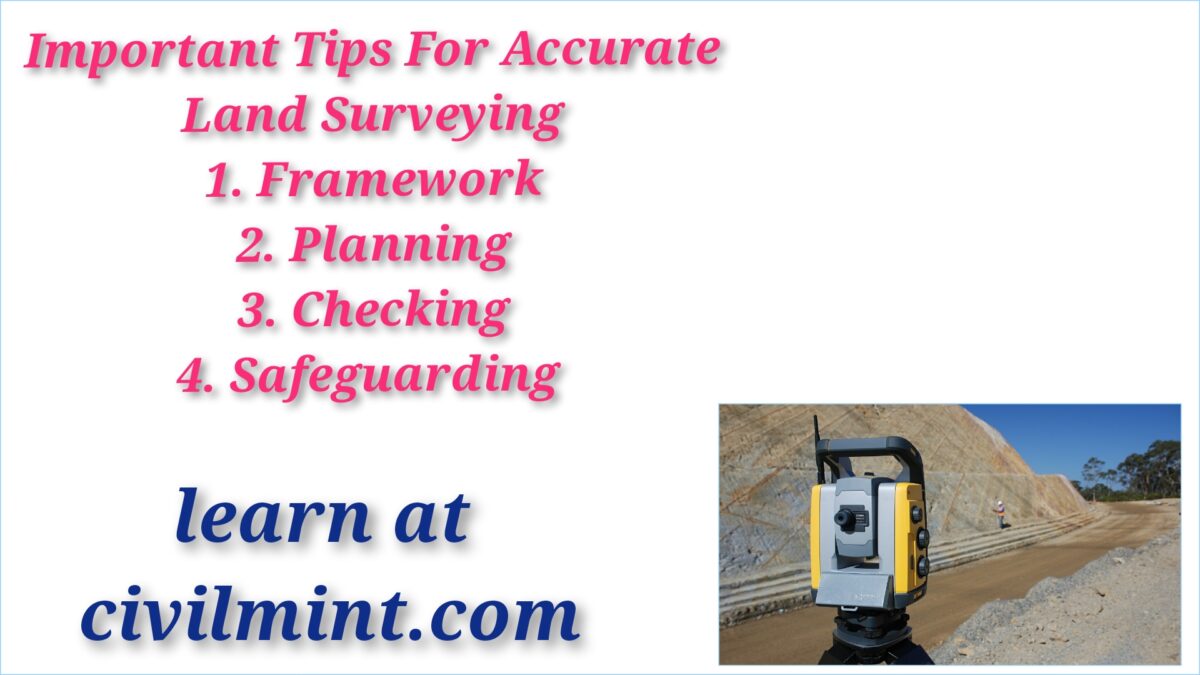In this article, we will learn some very important tips for an accurate land surveying.

Surveying, even though it is of diverse nature, there are some important tips that are common to all branches of surveying. These tips have proved over the years to be crucial if accurate surveys are to be conducted.
Table of Contents
Tips For Accurate Land Surveying:
There are 4 most important tips which must be followed to get accurate results of the survey.
- Initial Framework.
- Planning.
- Checking.
- Safeguarding.
A brief description of these survey tips has been described.
1. Initial Framework:
Providing an initial framework before spotting and setting the detail of a survey is very crucial for accurate survey work. The framework of the survey means the establishment of control points and subsidiary points as a benchmark. The control points must be established with high accuracy than subsidiary points.
To accomplish this guideline, the accumulation of inevitable errors can be eliminated and the occurred errors can be controlled within the framework. This process is also known as providing control.
2. Planning:
Planning is the second most important thing of surveying. Most of the surveys are done without proper planning which results in uneven effects on the budget of the project. In the survey cost and accuracy, the relationship is not linear. For example, if a length of 500 m is to be determined to an accuracy of either 5 mm or 0.5 mm, the cost ratio of respective accuracy may be the order of 1:300. Thus, an increase in accuracy will have unbalanced effects on cost.
With the right planning, one can choose the required techniques, correct instruments for the survey. By careful observation of the area, the most appropriate method for given topography can also be known. All of these factors come under planning. Time spent on planning and reconnaissance mission is never wasted.
3. Checking:
To eradicate or minimize the errors, sufficient independent checks at every stage of surveying are suggested. Every stage in the survey refers from fieldwork to the final plotting.
Checking means not only taking repeated measurements of the given line or area but also ensuring cross-checks. The checking system should be independent and involved at all stages of surveying work. A few examples are given below for independent checks.
(a) Fieldwork Checking:
- Check the distance of lines in either direction.
- Measure angles using theodolite instrument.
- Measure the diagonals of a quadrilateral geometry.
(b) Computation Checking:
- A summation check should be done on angle observations of formed geometrical figures of the area. For example summation of interior angles equal to (2n-4) x 90o.
- Apply cross-checks for all leveling measurements.
(c) Final Plotting Check:
- Using angles and distances plot the important points of the survey also uses coordinates for the precise position of points.
4. Safeguarding:
Safeguarding measurements, field observations, and survey markers are very important tips to remember. All established survey points are marked with respect to the permanent reference or witness point within the vicinity of that marked point. If by any error marked point is damaged or missed from the observation, then these reference points will help to find an established point.

This condition arises primarily in road surveys where there is a big gap between the initial survey and the final setting out. The lasting survey points marked in this survey may become overgrown with vegetation and difficult to locate. In this condition, reference points play an important role to reestablish the permanent survey points.
Field observations must be safeguarded by maintaining a field book. A field book is utilized to record the observations at every stage. Leading results of surveying like rounds of angles, mean distance, etc can be calculated by summarizing the abstract sheets of the field book. The field book must be stored cautiously.
